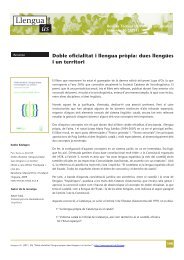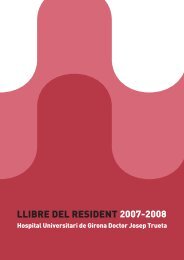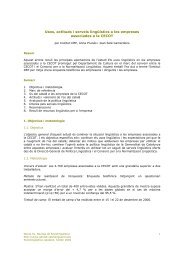Language Policy in the Russian Federation: language diversity and ...
Language Policy in the Russian Federation: language diversity and ...
Language Policy in the Russian Federation: language diversity and ...
You also want an ePaper? Increase the reach of your titles
YUMPU automatically turns print PDFs into web optimized ePapers that Google loves.
<strong>Language</strong> <strong>Policy</strong> <strong>in</strong> <strong>the</strong> <strong>Russian</strong> <strong>Federation</strong>: <strong>language</strong> <strong>diversity</strong> <strong>and</strong><br />
national identity<br />
by Marc Leprêtre<br />
Abstract<br />
This paper gives an overview on <strong>the</strong> different <strong>language</strong> policies implemented <strong>in</strong> <strong>the</strong> <strong>Russian</strong> <strong>Federation</strong>,<br />
stress<strong>in</strong>g <strong>the</strong> relevance of <strong>the</strong> historical background, <strong>the</strong> relations between <strong>language</strong> <strong>and</strong> nationalism,<br />
<strong>and</strong> <strong>language</strong> promotion as a tool for prevent<strong>in</strong>g <strong>in</strong>ter-ethnic conflicts <strong>and</strong> for ensur<strong>in</strong>g a peaceful <strong>and</strong><br />
balanced l<strong>in</strong>guistic <strong>diversity</strong>. The text is structured <strong>in</strong> four sections: historical overview (<strong>language</strong> policy<br />
<strong>and</strong> nation-build<strong>in</strong>g <strong>in</strong> <strong>the</strong> USSR); <strong>in</strong>terethnic tensions <strong>in</strong> <strong>the</strong> <strong>Russian</strong> <strong>Federation</strong> <strong>in</strong> <strong>the</strong> post-Soviet<br />
context; <strong>the</strong> awaken<strong>in</strong>g of national groups <strong>in</strong> Russia; <strong>and</strong> strategies for a peaceful <strong>and</strong> balanced<br />
management of l<strong>in</strong>guistic <strong>diversity</strong> <strong>in</strong> <strong>the</strong> <strong>Russian</strong> <strong>Federation</strong> <strong>and</strong> <strong>the</strong> Soviet successor states. 1<br />
1. Historical overview: <strong>language</strong> policy <strong>and</strong> nation-build<strong>in</strong>g <strong>in</strong> <strong>the</strong> USSR<br />
The processes of <strong>language</strong> plann<strong>in</strong>g <strong>and</strong> <strong>language</strong> policy carried on s<strong>in</strong>ce 1991 <strong>in</strong> <strong>the</strong> <strong>Russian</strong> <strong>Federation</strong><br />
can't be expla<strong>in</strong>ed without a short reference to <strong>the</strong> historical, political <strong>and</strong> social outcomes raised by <strong>the</strong><br />
nationality <strong>and</strong> <strong>language</strong> policies implemented dur<strong>in</strong>g decades <strong>in</strong> <strong>the</strong> former USSR. Never<strong>the</strong>less, <strong>in</strong>sofar as<br />
<strong>the</strong> topic of this paper is what is go<strong>in</strong>g on nowadays regard<strong>in</strong>g <strong>the</strong> management of <strong>language</strong> <strong>diversity</strong>, I will<br />
try to summarize this historical background 2 .<br />
The ideological bases of <strong>the</strong> Soviet nationality policies <strong>and</strong> <strong>the</strong> process of nationalization 3 implemented <strong>in</strong> <strong>the</strong><br />
republics had a ra<strong>the</strong>r paradoxical character as far as on <strong>the</strong> one h<strong>and</strong> <strong>the</strong> Soviet regime entitled <strong>the</strong><br />
nationalities with a well-def<strong>in</strong>ed political <strong>and</strong> territorial status -even for those which had not yet reached a<br />
pre-capitalist level of development- which led to a process of nation-build<strong>in</strong>g where political <strong>and</strong> territorial<br />
units were created on <strong>the</strong> basis of nations that constituted <strong>the</strong>mselves as historical cultural communities<br />
dur<strong>in</strong>g <strong>the</strong> Tsarist period, contrary to what had been <strong>the</strong> usual pattern <strong>in</strong> Western Europe. On <strong>the</strong> o<strong>the</strong>r<br />
h<strong>and</strong>, <strong>the</strong>se processes took place <strong>in</strong> a parallel way with a gradual policy of repression of national historical<br />
cultures that only preserved <strong>the</strong> most ethnographic <strong>and</strong> folkloric elements. Fur<strong>the</strong>rmore, <strong>and</strong> accord<strong>in</strong>g to<br />
<strong>the</strong> analysis proposed by Gellner regard<strong>in</strong>g <strong>the</strong> formation of nations dur<strong>in</strong>g <strong>the</strong> processes of modernization 4 ,<br />
we can argue that Soviet Marxism-Len<strong>in</strong>ism did not consider <strong>the</strong> peripheral nationalities has deep rooted<br />
societies <strong>in</strong> <strong>the</strong> modern economic <strong>and</strong> politic structures, but ra<strong>the</strong>r as 'folkloric' or 'ethnographic' nations.<br />
Noneless, <strong>the</strong> logical ground of Bolshevik policy towards nationalities after <strong>the</strong> Revolution - <strong>the</strong><br />
korenizatsiia 5 - constituted a formula accord<strong>in</strong>g to which those nations whose collective rights had been<br />
denied <strong>and</strong> repressed dur<strong>in</strong>g <strong>the</strong> Tsarist period should have access to <strong>the</strong> free exercise of <strong>the</strong>se rights with<strong>in</strong><br />
<strong>the</strong> general framework of <strong>the</strong> build<strong>in</strong>g of socialism <strong>in</strong> order to reach by <strong>the</strong>mselves <strong>the</strong> conclusion that<br />
national sovereignty was not by itself a solution to all <strong>the</strong> national, cultural, social, politic <strong>and</strong> economic<br />
problems of development. The f<strong>in</strong>al goal was <strong>the</strong>refore <strong>the</strong> merger of all nations <strong>in</strong>to a s<strong>in</strong>gle socialist<br />
community, once all national cultures had had <strong>the</strong> opportunity to bloom dur<strong>in</strong>g <strong>the</strong> period of construction of<br />
socialism as stressed by Stal<strong>in</strong> at <strong>the</strong> XVI Congress of <strong>the</strong> CP(b)SU 6 <strong>in</strong> 1930 7 .<br />
This policy was likewise aimed to be a lenitive for <strong>the</strong> social, political <strong>and</strong> national tensions that emerged<br />
successively <strong>in</strong> <strong>the</strong> cities, <strong>the</strong> rural areas <strong>and</strong> <strong>the</strong> periphery of <strong>the</strong> State dur<strong>in</strong>g <strong>the</strong> Revolution, <strong>the</strong> Civil<br />
War <strong>and</strong> <strong>the</strong> process of build<strong>in</strong>g of <strong>the</strong> Soviet state. In order to solve <strong>the</strong>se tensions, <strong>the</strong> Bolsheviks<br />
implemented simultaneously three k<strong>in</strong>ds of policies: <strong>the</strong> application of <strong>the</strong> pr<strong>in</strong>ciple of national-territorial<br />
autonomy as <strong>the</strong> cornerstone of <strong>the</strong> recently created Socialist Federative Soviet Republic of Russia; <strong>the</strong><br />
formation of autonomous territorial units <strong>in</strong> peripheral regions; <strong>and</strong> <strong>the</strong> implementation of korenizatsiia<br />
at large scale. At <strong>the</strong> same time, <strong>the</strong>se policies were followed by two corollaries to ensure full support<br />
from peasants <strong>and</strong> urban workers to <strong>the</strong> regime: <strong>the</strong> NEP <strong>and</strong> <strong>the</strong> massive enlistment of proletarians <strong>in</strong>to<br />
<strong>the</strong> Party. From a sociol<strong>in</strong>guistic po<strong>in</strong>t of view, <strong>the</strong> outcomes of <strong>the</strong> Soviet nationality policies can be<br />
1 The author is grateful <strong>and</strong> <strong>in</strong>debted for <strong>the</strong> support <strong>and</strong> contributions to Jordi Bañeres (Institute of Catalan<br />
Sociol<strong>in</strong>guistics), Zurab Dvali (TV <strong>and</strong> Radio Broadcast<strong>in</strong>g of Georgia, Tbilissi); Dr. Ayla Göl (Department of<br />
International Relations, Ankara University); Prof. Ruth Ferrero (UNED); Dr. François Gr<strong>in</strong> (Adjunct Director of<br />
Geneva’s Service for Education Research <strong>and</strong> Senior Lecturer at <strong>the</strong> University of Geneva); Bossia Kornoussova<br />
(Kalmyk Centre for Intensive <strong>Language</strong> Teach<strong>in</strong>g, Elista, Kalmykia); Marsal<strong>in</strong>a Tsyrenjapova (Center for <strong>Policy</strong><br />
Research, Moscow), <strong>and</strong> Dr. Alexey Yeschenko (Director of <strong>the</strong> North-Caucasian Institute of L<strong>in</strong>guistics, Pyatigorsk).<br />
The usual disclaimer applies.<br />
2 For fur<strong>the</strong>r details <strong>and</strong> <strong>in</strong>-depth analysis see Kirkwood (1989) <strong>and</strong> Liber (1991).<br />
3 Natsionalnoe stroiteltsvo [construction of nations] has broadly speak<strong>in</strong>g <strong>the</strong> same mean<strong>in</strong>g that <strong>the</strong> concept of 'nationbuild<strong>in</strong>g'<br />
which will be used from now onwards.<br />
4 Gellner (1983).<br />
5 Nationalisation policy of <strong>the</strong> State’s nations <strong>and</strong> ethnic groups applied dur<strong>in</strong>g <strong>the</strong> 20’s, overlapp<strong>in</strong>g with <strong>the</strong> N.E.P.<br />
[Novaya Ekonomicheskaya Politika].<br />
6 Communist Party (bolsheviks) of <strong>the</strong> Soviet Union [official name of <strong>the</strong> Parti until 1936].<br />
7 See Bogdan, 1993:219.<br />
Noves SL. Revista de Sociol<strong>in</strong>güística 1<br />
http://www.gencat.cat/llengua/noves<br />
Sociol<strong>in</strong>güística <strong>in</strong>ternacional. Primavera 2002
summed up as follows: “La politique l<strong>in</strong>guistique est sans aucun doute le plus orig<strong>in</strong>al de l’action menée par<br />
le pouvoir en matière nationale. C’est aussi, cela est certa<strong>in</strong>, sa plus parfaite réussite 8 ”.<br />
Actually <strong>the</strong> different <strong>language</strong> policies implemented <strong>in</strong> <strong>the</strong> Soviet Union are for sure one of <strong>the</strong> most<br />
salient achievements of <strong>the</strong> regime <strong>in</strong>sofar as we can't detach <strong>the</strong>m from <strong>the</strong> political, social <strong>and</strong><br />
economic events which took place dur<strong>in</strong>g seven decades nei<strong>the</strong>r from <strong>the</strong> changes <strong>in</strong> <strong>the</strong> correlations of<br />
forces with<strong>in</strong> <strong>the</strong> top ranks of <strong>the</strong> State <strong>and</strong> of <strong>the</strong> federated republics. The changes <strong>in</strong> <strong>the</strong> demographic<br />
structure of <strong>the</strong> population dur<strong>in</strong>g <strong>the</strong> process of modernization of Soviet economy <strong>and</strong> society<br />
contributed likewise to streng<strong>the</strong>n, especially <strong>in</strong> <strong>the</strong> urban areas, <strong>the</strong> tensions raised by <strong>the</strong> contacts<br />
between <strong>language</strong>s toge<strong>the</strong>r with o<strong>the</strong>r factors as <strong>the</strong> size of l<strong>in</strong>guistic <strong>and</strong> national groups, <strong>the</strong><br />
experience (historical o recent) of contacts with o<strong>the</strong>r ethnic groups, <strong>the</strong> geographic location or concrete<br />
l<strong>in</strong>guistic, religious <strong>and</strong> cultural k<strong>in</strong>ships. Insofar as <strong>the</strong> policies implemented by <strong>the</strong> State <strong>in</strong> order to<br />
ensure <strong>the</strong> equality between nations were based on <strong>the</strong> Marxist-Len<strong>in</strong>ist <strong>in</strong>terpretation of <strong>the</strong> dialectical<br />
relations established between <strong>the</strong> different nationalities, <strong>the</strong> underly<strong>in</strong>g motivations of l<strong>in</strong>guistic <strong>and</strong><br />
national policies were that <strong>the</strong> modernization of <strong>the</strong> different ethnic groups of <strong>the</strong> USSR could not be<br />
achieved if <strong>the</strong> autochthonous populations didn't manage to reach a high level of literacy, culture <strong>and</strong> social<br />
<strong>and</strong> political consciousness. At <strong>the</strong> same time, <strong>the</strong> new needs of <strong>the</strong> Soviet society (<strong>in</strong>dustrialization,<br />
technologic challenges, build<strong>in</strong>g of socialism) required <strong>the</strong> creation of a new society with an adequate critical<br />
mass of <strong>in</strong>dividuals able to deal with new technical <strong>and</strong> <strong>in</strong>tellectual tools <strong>in</strong> order to implement <strong>and</strong> make real<br />
<strong>the</strong> projects designed by <strong>the</strong> State. On <strong>the</strong> o<strong>the</strong>r h<strong>and</strong>, <strong>the</strong> Socialist Revolution happened <strong>in</strong> a country which<br />
didn't possess <strong>the</strong> objective conditions for its consolidation - <strong>the</strong> structure of <strong>the</strong> population was<br />
overwhelm<strong>in</strong>gly formed by peasant, <strong>the</strong> urban proletariat was scarce, <strong>the</strong> level of <strong>in</strong>dustrialization still<br />
low accord<strong>in</strong>g to Western st<strong>and</strong>ards as well as <strong>the</strong> political <strong>and</strong> cultural development of <strong>the</strong> populationalthough<br />
<strong>the</strong> new regime managed to set up new structures of power after a long civil war.<br />
Never<strong>the</strong>less, <strong>the</strong> streng<strong>the</strong>n<strong>in</strong>g of <strong>the</strong> new State <strong>and</strong> <strong>the</strong> build<strong>in</strong>g of socialism required a radical change<br />
<strong>in</strong> <strong>the</strong> social, political, cultural <strong>and</strong> economic composition of <strong>the</strong> country. As far as <strong>the</strong> <strong>in</strong>dustrialization of<br />
<strong>the</strong> USSR was a s<strong>in</strong>e qua non condition for its own survival, <strong>the</strong> most effective <strong>and</strong> fast way to ga<strong>in</strong> <strong>the</strong><br />
support (or neutrality) of <strong>the</strong> non-<strong>Russian</strong> nationalities, as well as to <strong>in</strong>culcate <strong>in</strong>to <strong>the</strong>m <strong>the</strong> new political<br />
culture was to use <strong>the</strong> autochthonous <strong>language</strong>s as one of <strong>the</strong> ma<strong>in</strong> tools of this process of learn<strong>in</strong>g <strong>and</strong><br />
change. It was <strong>the</strong>refore necessary to set up a new educational system <strong>and</strong> new cultural, ideological <strong>and</strong><br />
communicative doma<strong>in</strong>s <strong>in</strong> different <strong>language</strong>s. This is <strong>the</strong> reason why <strong>language</strong> policy was from <strong>the</strong><br />
very beg<strong>in</strong>n<strong>in</strong>g one of <strong>the</strong> ma<strong>in</strong> cruxes of <strong>the</strong> Soviet policy towards nationalities. <strong>Language</strong> policy was<br />
carried on by <strong>the</strong> Narkomnats 9 by means of four ma<strong>in</strong> activities, namely: <strong>the</strong> selection of a st<strong>and</strong>ard<br />
code for every autochthonous <strong>language</strong> <strong>and</strong> its dissem<strong>in</strong>ation as a common <strong>language</strong> of communication<br />
for <strong>the</strong> populations of <strong>the</strong> autonomous territorial units; <strong>the</strong> modernization of <strong>the</strong> lexicon accord<strong>in</strong>g to <strong>the</strong><br />
needs of a modern <strong>in</strong>dustrial society; <strong>the</strong> reform or creation of new alphabets for <strong>the</strong> autochthonous<br />
<strong>language</strong>s; <strong>and</strong> <strong>the</strong> large-scale literacy campaign <strong>in</strong> <strong>the</strong> peripheral regions by means of <strong>the</strong> teach<strong>in</strong>g of <strong>the</strong><br />
autochthonous <strong>language</strong>s <strong>in</strong> new national school systems. As a long term result of this k<strong>in</strong>d of policies, at<br />
<strong>the</strong> end of <strong>the</strong> Soviet Union <strong>the</strong> overall picture of <strong>the</strong> sociol<strong>in</strong>guistic situation of both <strong>the</strong> autochthonous<br />
<strong>language</strong>s <strong>and</strong> <strong>Russian</strong> as <strong>the</strong> common <strong>language</strong> of communication between all <strong>the</strong> parts of <strong>the</strong> State<br />
was as follows:<br />
Ethnic groups, knowledge of <strong>Russian</strong> <strong>and</strong> of <strong>the</strong> <strong>language</strong> of <strong>the</strong> titular ethnic group (1989)<br />
Republic Majority groups (%) % Knowledge of<br />
<strong>Russian</strong><br />
Armenia Armenians (93)<br />
Azeris (3)<br />
Azerbaidjan Azeris (83)<br />
<strong>Russian</strong>s (6)<br />
Armenians (6)<br />
Belarus Belorussians (78)<br />
<strong>Russian</strong>s (13)<br />
Estonia Estonians (62)<br />
<strong>Russian</strong>s (30)<br />
Georgia Georgians (70)<br />
Armenians (8)<br />
<strong>Russian</strong>s (6)<br />
Azeris (6)<br />
Kazakhstan Kazakhs (40)<br />
<strong>Russian</strong>s (38)<br />
45<br />
19<br />
32<br />
--<br />
69<br />
80<br />
--<br />
35<br />
--<br />
32<br />
52<br />
--<br />
35<br />
64<br />
--<br />
% Knowledge of <strong>language</strong><br />
of titular ethnic group by<br />
o<strong>the</strong>r groups<br />
--<br />
7<br />
--<br />
15<br />
7<br />
--<br />
27<br />
--<br />
15<br />
--<br />
26<br />
24<br />
10<br />
--<br />
9<br />
8 Carrère d’Encausse, 1978:203.<br />
9 Narodnii Kommissariat po Delam Natsionalnostei [People's Commissariat for Nationalities Affairs].<br />
Noves SL. Revista de Sociol<strong>in</strong>güística 2<br />
http://www.gencat.cat/llengua/noves<br />
Sociol<strong>in</strong>güística <strong>in</strong>ternacional. Primavera 2002
Kyrgyztan Kyrgyz (52)<br />
<strong>Russian</strong>s (22)<br />
Uzbeks (13)<br />
37<br />
--<br />
39<br />
--<br />
12<br />
4<br />
Latvia Latvians (52)<br />
<strong>Russian</strong>s (34)<br />
68<br />
--<br />
--<br />
22<br />
Lithuania Lithuanians (80)<br />
<strong>Russian</strong>s (9)<br />
Poles (7)<br />
38<br />
--<br />
67<br />
--<br />
38<br />
21<br />
Moldova Moldovans (65)<br />
Ukra<strong>in</strong>ians (14)<br />
<strong>Russian</strong>s (13)<br />
58<br />
80<br />
--<br />
--<br />
14<br />
12<br />
Tadjikistan Tadjiks (62)<br />
Uzbeks (24)<br />
<strong>Russian</strong>s (8)<br />
31<br />
22<br />
--<br />
--<br />
17<br />
4<br />
Turkmenistan Turkmens (72)<br />
<strong>Russian</strong>s (10)<br />
Uzbeks (9)<br />
28<br />
--<br />
29<br />
--<br />
2<br />
16<br />
Ukra<strong>in</strong>e Ukra<strong>in</strong>ians (73)<br />
<strong>Russian</strong>s (22)<br />
72<br />
--<br />
--<br />
34<br />
Uzbekistan Uzbeks (71)<br />
<strong>Russian</strong>s (8)<br />
27<br />
--<br />
--<br />
5<br />
Source: Own elaboration from <strong>the</strong> data provided by Natsionalnii Sostav Naseleniia SSSR (1991).<br />
In short, Soviet <strong>language</strong> policy not only promoted <strong>the</strong> <strong>Russian</strong> <strong>language</strong> as <strong>the</strong> ‘l<strong>in</strong>gua franca’ used for All-<br />
Union <strong>and</strong> <strong>in</strong>ter-republican communications, but also improved <strong>and</strong> streng<strong>the</strong>ned <strong>the</strong> position of <strong>the</strong> titular<br />
nations of <strong>the</strong> republics as well as that of <strong>the</strong>ir respective <strong>language</strong>s. At <strong>the</strong> same time, <strong>the</strong> gradual decl<strong>in</strong>e<br />
of <strong>the</strong> percentage of ethnic <strong>Russian</strong>s <strong>in</strong> <strong>the</strong> USSR <strong>and</strong> a birth rate dramatically lower than that of <strong>the</strong><br />
populations of Central Asia <strong>and</strong> Caucasus contributed to create a latent feel<strong>in</strong>g of <strong>in</strong>security with<strong>in</strong> <strong>the</strong><br />
majority group which provoked <strong>the</strong> rais<strong>in</strong>g of a new type of <strong>Russian</strong> nationalism as a reaction towards <strong>the</strong><br />
<strong>in</strong>tensification of nationalists movements <strong>in</strong> <strong>the</strong> borders <strong>and</strong> <strong>the</strong> core itself of <strong>the</strong> Union. F<strong>in</strong>ally, <strong>the</strong><br />
outcomes of <strong>the</strong> Soviet <strong>language</strong> policy reflect <strong>the</strong> contradictions <strong>in</strong> <strong>the</strong> processes of centralization <strong>and</strong><br />
decentralization <strong>and</strong> those of promotion <strong>and</strong> repression which constituted <strong>the</strong> ma<strong>in</strong> characteristics of Soviet<br />
nationalities policies splitted between <strong>the</strong> class strategy <strong>and</strong> <strong>the</strong> nationalist tacticism.<br />
2. Interethnic tensions <strong>in</strong> <strong>the</strong> <strong>Russian</strong> <strong>Federation</strong> <strong>in</strong> <strong>the</strong> post-Soviet context<br />
The break-up of <strong>the</strong> Soviet Union <strong>and</strong> <strong>the</strong> <strong>in</strong>crease of <strong>in</strong>terethnic tensions with<strong>in</strong> <strong>the</strong> very same <strong>Russian</strong><br />
<strong>Federation</strong> implied <strong>the</strong> <strong>in</strong>tensification of <strong>the</strong> <strong>Russian</strong> identity crisis that had been tak<strong>in</strong>g place dur<strong>in</strong>g <strong>the</strong><br />
process of construction of <strong>the</strong> Soviet patriotism from <strong>the</strong> mid 30’s. The first signs of tension co<strong>in</strong>cided<br />
with <strong>the</strong> declaration of sovereignty of <strong>the</strong> Autonomous Republics of Mari El, Komi <strong>and</strong> Tatarstan dur<strong>in</strong>g<br />
<strong>the</strong> summer of 1990. These declarations of sovereignty meant an attempt to force <strong>the</strong> federal authorities<br />
<strong>in</strong>to grant<strong>in</strong>g <strong>the</strong>m a higher level of autonomy that would allow local authorities to control <strong>and</strong> manage<br />
<strong>the</strong>ir natural resources (diamonds, petroleum, gas, wood <strong>in</strong>dustry) <strong>in</strong> order to have direct access to<br />
foreign markets.<br />
The <strong>in</strong>itial negotiations aim<strong>in</strong>g at <strong>the</strong> signature of <strong>the</strong> Union Treaty of 1991 accelerated this process <strong>in</strong><br />
such a way that, not only <strong>the</strong> sixteen Autonomous Republics of <strong>the</strong> RSFSR declared <strong>the</strong>ir sovereignty,<br />
but also <strong>the</strong> Autonomous Regions of Birobidzhan, Karachaevo-Cherkessia, Khakassia, Gorno-Altay <strong>and</strong><br />
Adygea, which claimed <strong>the</strong>ir conversion <strong>in</strong>to Autonomous Republics, also did <strong>the</strong> same. In addition, as<br />
was <strong>the</strong> case at <strong>the</strong> beg<strong>in</strong>n<strong>in</strong>g of <strong>the</strong> 20’s, new territorial entities with no legal basis emerged,<br />
constituted from <strong>the</strong> unilateral decisions taken by local Soviets: <strong>the</strong> Greater Volga Association; <strong>the</strong><br />
Greater Ural Association; <strong>the</strong> Far East Association; <strong>the</strong> Association of <strong>the</strong> Towns of Sou<strong>the</strong>rn Russia; <strong>the</strong><br />
aforementioned old Autonomous Regions reconverted <strong>in</strong>to Autonomous Republics; <strong>the</strong> de facto<br />
<strong>in</strong>dependent Republic of Chechnya; <strong>and</strong> f<strong>in</strong>ally, <strong>the</strong> Tyumen District. Thus, Russia faced, throughout <strong>the</strong><br />
entire Soviet State, a process of territorial, economic <strong>and</strong> social dis<strong>in</strong>tegration which had marked<br />
consequences on <strong>the</strong> configuration of a new national identity which, for <strong>the</strong> first time s<strong>in</strong>ce <strong>the</strong> Middle<br />
Ages, had to dissociate <strong>the</strong> concepts of Empire <strong>and</strong> State.<br />
Likewise <strong>the</strong> <strong>Russian</strong> nation nowadays faces an acute crisis of national identity <strong>and</strong> is look<strong>in</strong>g for its own<br />
self-def<strong>in</strong>ition. In contrast with <strong>the</strong> classical paradigm accord<strong>in</strong>g to which <strong>the</strong> national <strong>and</strong> identity issue<br />
is ma<strong>in</strong>ly <strong>the</strong> concern of ‘<strong>in</strong>complete nations’ 10 that are struggl<strong>in</strong>g to reaffirm <strong>the</strong>mselves <strong>in</strong> <strong>the</strong> face of<br />
10 See Gellner (1983).<br />
Noves SL. Revista de Sociol<strong>in</strong>güística 3<br />
http://www.gencat.cat/llengua/noves<br />
Sociol<strong>in</strong>güística <strong>in</strong>ternacional. Primavera 2002
larger <strong>and</strong> more ‘complete’ nations, <strong>in</strong> today’s Russia it is <strong>the</strong> dom<strong>in</strong>ant ethnic group who is look<strong>in</strong>g for<br />
its self-def<strong>in</strong>ition. Broadly speak<strong>in</strong>g, <strong>the</strong> existence of a <strong>Russian</strong> State (Rossiiskoe Gosudartsvo) was<br />
previous to <strong>the</strong> <strong>Russian</strong> nation(ality) (Russkaya narodnost) <strong>and</strong>, at <strong>the</strong> same time, <strong>the</strong> <strong>Russian</strong> Empire<br />
preceded <strong>the</strong> <strong>Russian</strong> State. Accord<strong>in</strong>g to this, <strong>the</strong> emergency of Russia as a nation was <strong>in</strong>fallibly l<strong>in</strong>ked<br />
to <strong>the</strong> cont<strong>in</strong>uous process of expansion of <strong>the</strong> Empire towards <strong>the</strong> territories <strong>in</strong>habited by alien ethnic<br />
groups. Ano<strong>the</strong>r feature of <strong>the</strong> <strong>Russian</strong> Empire, later on shared with <strong>the</strong> Soviet Union, was found <strong>in</strong> <strong>the</strong><br />
relations that were established between <strong>the</strong> <strong>Russian</strong> Nation <strong>and</strong> alien peoples. Dur<strong>in</strong>g Tsarism, <strong>the</strong><br />
dom<strong>in</strong>ant classes of <strong>the</strong> peripheral societies were progressively assimilated by <strong>the</strong> elites of <strong>the</strong> center,<br />
such as was <strong>the</strong> case of <strong>the</strong> Tatars, <strong>the</strong> Georgians, <strong>the</strong> Germans, <strong>the</strong> Balts or <strong>the</strong> Poles. Dur<strong>in</strong>g some<br />
specific periods of <strong>the</strong> Communist regime, this same type of relationship was established, <strong>in</strong>sofar as<br />
class or ideological considerations prevailed over ethnic identifications. In addition, dur<strong>in</strong>g <strong>the</strong> period of<br />
<strong>the</strong> korenizatsiia to be <strong>Russian</strong> or to belong to a Russified national elite implied a curb on <strong>in</strong>dividuals who<br />
aspired to hold<strong>in</strong>g important positions <strong>in</strong> <strong>the</strong> national Republics.<br />
On <strong>the</strong> o<strong>the</strong>r h<strong>and</strong>, <strong>the</strong> very same <strong>Russian</strong>s did not consider <strong>the</strong>mselves as a particularly favoured nation<br />
by <strong>the</strong> previous regime: <strong>the</strong> economic <strong>in</strong>dicators of <strong>the</strong> RSFSR were not substantially better than those<br />
of <strong>the</strong> o<strong>the</strong>r Republics, <strong>the</strong> purges of <strong>the</strong> 30’s had caused more victims <strong>the</strong>re than anywhere else, <strong>the</strong><br />
<strong>Russian</strong>s had contributed more than any o<strong>the</strong>r people to <strong>the</strong> Second World War, <strong>the</strong> environmental<br />
situation was awful, ethnical m<strong>in</strong>orities identified <strong>the</strong>m with Soviet totalitarianism, <strong>the</strong>ir contribution to<br />
<strong>the</strong> ma<strong>in</strong>tenance of <strong>the</strong> Centro-Asiatic Republics was considerable, etc. F<strong>in</strong>ally, from <strong>the</strong> political po<strong>in</strong>t of<br />
view, <strong>the</strong> RSFSR was <strong>in</strong> no way privileged s<strong>in</strong>ce it shared same rank with a great number of smaller<br />
ethnical groups <strong>and</strong> it was even under-represented from <strong>the</strong> <strong>in</strong>stitutional po<strong>in</strong>t of view, <strong>in</strong>sofar as many<br />
All-Union <strong>in</strong>stitutions took <strong>the</strong> place of <strong>Russian</strong> <strong>in</strong>stitutions. From this po<strong>in</strong>t of view, <strong>the</strong> access to<br />
<strong>in</strong>dependence has not implied an improvement <strong>in</strong> <strong>the</strong> situation.<br />
While <strong>the</strong> loss of territories <strong>in</strong>cluded <strong>in</strong> <strong>the</strong> <strong>Russian</strong> Empire <strong>and</strong> later on <strong>in</strong> <strong>the</strong> Soviet Union (especially<br />
Central Asia <strong>and</strong> Transcaucasia) was not a very traumatic experience, <strong>the</strong> secession of Belarus <strong>and</strong><br />
Ukra<strong>in</strong>e was <strong>in</strong>terpreted as an historic, identity <strong>and</strong> cultural amputation. In addition, <strong>the</strong> new map of <strong>the</strong><br />
borders has turned almost 25 million ethnic <strong>Russian</strong>s <strong>in</strong>to foreign citizens <strong>in</strong> <strong>the</strong> old Federated Republics<br />
that many had long s<strong>in</strong>ce considered to be <strong>the</strong>ir homel<strong>and</strong>. Although <strong>the</strong> disappearance of <strong>the</strong> Soviet<br />
State has allowed <strong>the</strong> <strong>Russian</strong>s to go from be<strong>in</strong>g a little bit more than 50% of <strong>the</strong> USSR’s population to<br />
represent more than 80% of <strong>the</strong> <strong>Russian</strong> <strong>Federation</strong>, <strong>the</strong> re<strong>in</strong>forcement of <strong>the</strong> <strong>Russian</strong>s as an ethnic<br />
majority <strong>in</strong> stark contrast with a multiplicity of ethnic m<strong>in</strong>orities has even more highlighted <strong>the</strong> idea that<br />
Russia is not only <strong>the</strong> State of <strong>the</strong> <strong>Russian</strong>s but that <strong>the</strong> <strong>Russian</strong> identity must also <strong>in</strong>tegrate alien<br />
elements. As a last resort, <strong>the</strong> present <strong>Russian</strong> <strong>Federation</strong> reproduces, on a smaller scale, <strong>the</strong> traditional<br />
contradiction between <strong>the</strong> ethnic <strong>and</strong> cultural groups <strong>and</strong> <strong>the</strong> political <strong>and</strong> territorial variables of <strong>the</strong><br />
<strong>Russian</strong> national identity.<br />
This situation becomes more complex because <strong>the</strong> <strong>Russian</strong> <strong>Federation</strong> is made up of 89 subjects (of<br />
which 32 are def<strong>in</strong>ed accord<strong>in</strong>g to ethnic terms) between old Autonomous Republics, regions, districts<br />
<strong>and</strong> federal towns, all with equal rights <strong>and</strong> obligations accord<strong>in</strong>g to <strong>the</strong> 1993 Constitution. But given <strong>the</strong><br />
fact that <strong>the</strong> 1992 Federal Treaty appears to be more generous towards <strong>the</strong> Republics, <strong>the</strong>re exists a<br />
duplicity of <strong>in</strong>terpretations as regards <strong>the</strong> responsibilities that must be assumed by <strong>the</strong> federal<br />
<strong>in</strong>stitutions <strong>and</strong> those correspond<strong>in</strong>g to <strong>the</strong> Republics. Therefore, after <strong>the</strong> break-up of <strong>the</strong> Soviet State,<br />
Russia has made its first steps along <strong>the</strong> path towards <strong>the</strong> recovery of its national identity <strong>and</strong> <strong>the</strong><br />
reconstruction of its nationality. This new <strong>Russian</strong> identity is based, broadly speak<strong>in</strong>g, on <strong>the</strong> Orthodox<br />
religion <strong>and</strong> a nationalism that reproduces, for lack of o<strong>the</strong>r models, <strong>the</strong> egalitarian, authoritarian <strong>and</strong><br />
communitarian schemata of <strong>the</strong> traditional <strong>Russian</strong> society. This search for a new identity takes place<br />
with<strong>in</strong> <strong>the</strong> framework of <strong>the</strong> traditional contradiction of a Russia split between its western aspirations<br />
<strong>and</strong> its tendency towards isolation. Be<strong>in</strong>g used to liv<strong>in</strong>g with<strong>in</strong> its own myths, <strong>Russian</strong> society looks for<br />
new social <strong>and</strong> moral po<strong>in</strong>ts of reference to f<strong>in</strong>d a new position as a nation, given <strong>the</strong> fact that <strong>the</strong> pre-<br />
Revolutionary myths based on religion, Empire <strong>and</strong> autocracy were elim<strong>in</strong>ated by <strong>the</strong> Bolshevik<br />
Revolution <strong>and</strong> were replaced by <strong>the</strong> new Bolshevik myths (proletarian <strong>in</strong>ternationalism, construction of<br />
socialism), now also disappeared.<br />
However, significant changes took place gradually <strong>in</strong> <strong>the</strong> subjective perception that <strong>the</strong> <strong>Russian</strong>s had<br />
<strong>the</strong>ir own identity, ma<strong>in</strong>ly as a consequence of <strong>the</strong> <strong>in</strong>crease <strong>and</strong> <strong>the</strong> radicalization of alien peoples’<br />
defense of <strong>the</strong>ir rights which provoked an unavoidable confrontation between <strong>the</strong> center <strong>and</strong> <strong>the</strong><br />
periphery. The <strong>Russian</strong>s entered <strong>in</strong>to direct competition with alien groups when claim<strong>in</strong>g <strong>the</strong> solution of<br />
<strong>in</strong>equalities <strong>and</strong> grievances; from becom<strong>in</strong>g aware of <strong>the</strong> huge f<strong>in</strong>ancial aids granted to <strong>the</strong> Federated<br />
Republics, <strong>the</strong> delicate environmental situation, <strong>the</strong> moral corruption of <strong>the</strong> Soviet society as a whole, to<br />
<strong>the</strong> real extension of <strong>the</strong> Stal<strong>in</strong>ist regime of terror <strong>and</strong> <strong>the</strong> arbitrar<strong>in</strong>ess’s of <strong>the</strong> previous decades, which<br />
resulted not only <strong>in</strong> an explosion of nationalist feel<strong>in</strong>gs <strong>in</strong> <strong>the</strong> Republics, but also encouraged <strong>the</strong> leaders<br />
of <strong>the</strong> periphery to elude <strong>the</strong>ir responsibilities by means of systematic attacks on <strong>the</strong> center <strong>and</strong> <strong>the</strong><br />
federal authorities identified with <strong>the</strong> <strong>Russian</strong>s. The latter, see<strong>in</strong>g that <strong>the</strong>y were associated with a policy<br />
<strong>and</strong> authorities that for seven decades had not treated <strong>the</strong>m <strong>in</strong> any way substantially different from <strong>the</strong><br />
way <strong>the</strong>y treated o<strong>the</strong>r Republics <strong>and</strong>, <strong>in</strong> addition, see<strong>in</strong>g <strong>the</strong>mselves as be<strong>in</strong>g deprived of national<br />
political, economic <strong>and</strong> cultural <strong>in</strong>stitutions because of <strong>the</strong> overlapp<strong>in</strong>g of <strong>the</strong> Soviet <strong>and</strong> <strong>Russian</strong><br />
<strong>in</strong>stitutions, launched a revival of a deeply ethnical <strong>Russian</strong> nationalism.<br />
Noves SL. Revista de Sociol<strong>in</strong>güística 4<br />
http://www.gencat.cat/llengua/noves<br />
Sociol<strong>in</strong>güística <strong>in</strong>ternacional. Primavera 2002
The emerg<strong>in</strong>g of nationalist movements at <strong>the</strong> heart of <strong>the</strong> RSFSR (Tatarstan, Yakutia-Sakha, Chechnya,<br />
Tuva, Buryatia, Dagestan, Nor<strong>the</strong>rn Ossetia, etc.) provoked a cha<strong>in</strong> reaction <strong>in</strong> <strong>the</strong> <strong>Russian</strong> population,<br />
<strong>in</strong> such a way that many <strong>Russian</strong> nationalist movements that arose under <strong>the</strong> protection of <strong>the</strong><br />
perestroika started, unlike <strong>the</strong>ir predecessors of <strong>the</strong> 70’s, to employ <strong>the</strong> centrifuge tactics of <strong>the</strong><br />
peripheral nationalist movements. In such a situation, faced with <strong>the</strong> <strong>in</strong>tensification of <strong>the</strong> anti-<strong>Russian</strong><br />
xenophobic feel<strong>in</strong>gs <strong>in</strong> <strong>the</strong> Transcaucasian <strong>and</strong> Centro-Asiatic Republics <strong>and</strong> <strong>the</strong> establishment of new<br />
legislations as regards <strong>language</strong>s <strong>and</strong> education that benefited autochthonous <strong>language</strong>s, <strong>the</strong> <strong>Russian</strong><br />
nationalists organized <strong>the</strong>mselves by creat<strong>in</strong>g popular fronts, as was happen<strong>in</strong>g <strong>in</strong> <strong>the</strong> Baltic countries or<br />
<strong>in</strong> Transcaucasia.<br />
This radicalization of <strong>Russian</strong> nationalism provoked a double confrontation between <strong>the</strong> RSFSR <strong>and</strong> <strong>the</strong><br />
Federated Republics, on <strong>the</strong> one h<strong>and</strong>, <strong>and</strong> between <strong>the</strong> very same RSFSR <strong>and</strong> <strong>the</strong> federal authorities,<br />
on <strong>the</strong> o<strong>the</strong>r. The fact that after <strong>the</strong> break-up of <strong>the</strong> USSR <strong>the</strong> <strong>Russian</strong> <strong>Federation</strong> still existed as a sole<br />
territorial entity with such a complex multiethnic composition gave rise among <strong>the</strong> <strong>Russian</strong> population to<br />
a feel<strong>in</strong>g that <strong>the</strong>ir country, now an orphan of reference po<strong>in</strong>ts on which to draw <strong>and</strong> construct a new<br />
identity, had simply become what was left of <strong>the</strong> USSR, once any <strong>in</strong>fluence on <strong>the</strong> o<strong>the</strong>r Federated<br />
Republics, some of which (Belarus <strong>and</strong> Ukra<strong>in</strong>e) constituted some of <strong>the</strong> symbolic references of Great<br />
Russia s<strong>in</strong>ce <strong>the</strong> X century, had been lost.<br />
The follow<strong>in</strong>g graph shows <strong>the</strong> ethnic composition <strong>in</strong> <strong>the</strong> autonomous republics of <strong>the</strong> <strong>Russian</strong><br />
<strong>Federation</strong>.<br />
Source: Own elaboration from <strong>the</strong> data provided by Natsionalnii Sostav Naseleniia SSSR (1991)<br />
The future articulation of <strong>the</strong> <strong>Russian</strong> national identity <strong>and</strong> State is extremely complex <strong>in</strong>sofar as, until<br />
now, it does not seem that <strong>the</strong>y have planned ei<strong>the</strong>r any coherent plan for development or any precise<br />
orientations on economic, social <strong>and</strong> national policies that would allow for <strong>the</strong> consolidation process of<br />
democracy <strong>in</strong> <strong>the</strong> <strong>Russian</strong> <strong>Federation</strong>. Faced with <strong>the</strong> outbreak of national <strong>and</strong> identity cohesion of post-<br />
Soviet Russia, <strong>the</strong> foundations on which <strong>the</strong> new identity <strong>and</strong> <strong>the</strong> new State should be based conta<strong>in</strong><br />
major contradictions, while <strong>the</strong> general context h<strong>in</strong>ders <strong>the</strong> articulation of a civil society traditionally<br />
underdeveloped, given <strong>the</strong> fact that, nei<strong>the</strong>r <strong>the</strong> concept of an ethnic Russia nor that of <strong>the</strong> imperial<br />
Russia can mobilize or unite <strong>the</strong> <strong>Russian</strong> citizens under <strong>the</strong> same national project; that <strong>the</strong> <strong>in</strong>tensification<br />
of <strong>the</strong> economic <strong>and</strong> regional particularities threaten to dislocate <strong>the</strong> territorial structure of <strong>the</strong><br />
<strong>Federation</strong>; that <strong>the</strong> moral <strong>and</strong> social disorientation is widespread among a population lack<strong>in</strong>g <strong>in</strong> po<strong>in</strong>ts<br />
of reference <strong>and</strong> core-values (very especially <strong>the</strong> youngsters) due to <strong>the</strong> disappearance of <strong>the</strong> old pre<strong>and</strong><br />
post-Communist values; <strong>and</strong> that <strong>the</strong> endemic economic crisis has driven tens of millions of people<br />
Noves SL. Revista de Sociol<strong>in</strong>güística 5<br />
http://www.gencat.cat/llengua/noves<br />
Sociol<strong>in</strong>güística <strong>in</strong>ternacional. Primavera 2002
to subsist below <strong>the</strong> poverty level. In short, <strong>the</strong> facts <strong>and</strong> circumstances made explicit throughout <strong>the</strong>se<br />
pages constitute a complex network that Russia will have to solve <strong>in</strong> order to beg<strong>in</strong> <strong>the</strong> process of<br />
democracy, political, social <strong>and</strong> economic stability <strong>and</strong> national reconstruction.<br />
3. The awaken<strong>in</strong>g of national groups <strong>in</strong> Russia<br />
The <strong>Russian</strong> <strong>Federation</strong> is made up of 176 national groups <strong>and</strong> an almost equal number of <strong>language</strong>s<br />
spoken. These m<strong>in</strong>ority communities represent approximately 28 million people, 20% of <strong>the</strong> total<br />
population 11 . This ethnic, l<strong>in</strong>guistic <strong>and</strong> cultural <strong>diversity</strong> is reflected <strong>in</strong> <strong>the</strong> Federal Statutes of <strong>the</strong><br />
country, with 21 National Republics, to which we have to add <strong>the</strong> Autonomous Regions <strong>and</strong> Districts.<br />
M<strong>in</strong>ority areas are characterized by a very strong <strong>in</strong>terweav<strong>in</strong>g of peoples. The <strong>Russian</strong> population<br />
represents between 30 <strong>and</strong> 80% of <strong>the</strong> population of <strong>the</strong> Republics <strong>in</strong> Siberia, between 30 <strong>and</strong> 70% of<br />
<strong>the</strong> central <strong>and</strong> nor<strong>the</strong>rn regions, <strong>and</strong> between 10 <strong>and</strong> 40% <strong>in</strong> <strong>the</strong> Caucasus. To it we have to add <strong>the</strong><br />
presence of o<strong>the</strong>r national groups which represent between 5 <strong>and</strong> 40% of <strong>the</strong> Republics’ population.<br />
Besides, <strong>the</strong> titular nationality (eponym of <strong>the</strong> Republic) constitutes <strong>the</strong> majority only <strong>in</strong> 8 of <strong>the</strong> 21<br />
Republics. Tak<strong>in</strong>g this multiculturalism <strong>in</strong>to consideration has implied <strong>the</strong> acknowledgement of a<br />
considerable political power <strong>in</strong> <strong>the</strong> titular m<strong>in</strong>orities, although this power often has to be relativised due<br />
to <strong>the</strong> absence or scarcity of f<strong>in</strong>ancial means <strong>and</strong> that Moscow still keeps an important <strong>in</strong>fluence through<br />
<strong>the</strong> subsidies (that may reach 90% of some Republics’ budget) <strong>and</strong> <strong>the</strong> grant<strong>in</strong>g of credits for <strong>the</strong><br />
acquisition <strong>and</strong> provision of energy supplies. In addition, <strong>the</strong> important sociocultural crisis that provoked<br />
<strong>the</strong> fall of Communism still perpetuates. Lett<strong>in</strong>g aside <strong>the</strong> North Caucasus, <strong>the</strong> UNESCO Red Book on<br />
Endangered <strong>Language</strong>s reports <strong>in</strong> Russia on only three m<strong>in</strong>ority <strong>language</strong>s that are not endangered 12 . All<br />
<strong>the</strong> o<strong>the</strong>rs are considered as be<strong>in</strong>g “on <strong>the</strong> verge of ext<strong>in</strong>ction” or “threatened”. This contrast between<br />
<strong>the</strong> will of reconstruct<strong>in</strong>g national identity <strong>and</strong> <strong>the</strong> real situation may imply a feel<strong>in</strong>g of urgency that<br />
sometimes force titular nationalities to take radical action <strong>in</strong> order to protect <strong>the</strong>ir <strong>language</strong> <strong>and</strong> <strong>the</strong>ir<br />
identity, while often at <strong>the</strong> same time political <strong>and</strong> social tensions feed on ethnical <strong>and</strong> cultural conflicts.<br />
With<strong>in</strong> this context, <strong>the</strong> l<strong>in</strong>guistic issue crystallizes <strong>in</strong> <strong>the</strong> dem<strong>and</strong> for <strong>the</strong> recognition of <strong>the</strong> identity of<br />
<strong>the</strong> different peoples of Russia, while this constitutes <strong>in</strong> itself a source of tensions. In <strong>the</strong> territories of<br />
<strong>the</strong> former Soviet Union, l<strong>in</strong>guistic decrees <strong>and</strong> laws have very significantly contributed to <strong>the</strong> worsen<strong>in</strong>g<br />
of <strong>the</strong> tensions <strong>in</strong> Moldova <strong>and</strong> <strong>language</strong> issues still mark <strong>the</strong> agenda of political action <strong>in</strong> <strong>the</strong> Baltic<br />
States, especially <strong>in</strong> Estonia <strong>and</strong> Latvia. In Central Asia, <strong>Russian</strong> m<strong>in</strong>orities are <strong>in</strong> a delicate situation<br />
because <strong>the</strong> use of national <strong>language</strong>s has become an important <strong>in</strong>dicator of <strong>the</strong> citizens’ political loyalty,<br />
although very often <strong>the</strong>y lack <strong>the</strong> necessary structures from which to learn <strong>the</strong>m. The situation seems<br />
less serious <strong>in</strong> Russia, where <strong>Russian</strong> still is globally accepted as a l<strong>in</strong>gua franca <strong>and</strong> where each<br />
Republic can add one or more official <strong>language</strong>s. But quite often <strong>the</strong> problem is to be found <strong>in</strong> <strong>the</strong><br />
criteria for choos<strong>in</strong>g <strong>the</strong>se official <strong>language</strong>s. All <strong>the</strong> Republics, except<strong>in</strong>g four of <strong>the</strong>m, have adopted<br />
l<strong>in</strong>guistic laws that give priority to <strong>the</strong> <strong>language</strong> of <strong>the</strong> titular nationality. In Bashkiria, <strong>the</strong> official status<br />
of <strong>the</strong> national <strong>language</strong> toge<strong>the</strong>r with <strong>Russian</strong> is <strong>the</strong> object of major controversy given <strong>the</strong> opposition of<br />
<strong>the</strong> Tatars -<strong>the</strong> second most important community <strong>in</strong> demographic weight after <strong>the</strong> <strong>Russian</strong>s <strong>and</strong> before<br />
<strong>the</strong> Bashkirians- because of <strong>the</strong> refusal of <strong>the</strong> Bashkirians to proclaim <strong>the</strong> official status of Tatar <strong>in</strong> <strong>the</strong><br />
Republic. The situation is especially complex <strong>in</strong> Dagestan where 80% of <strong>the</strong> population is Dagestani but<br />
more than 30 <strong>language</strong>s cohabit. Also, some decrees establish<strong>in</strong>g <strong>the</strong> adoption of <strong>the</strong> Lat<strong>in</strong> alphabet<br />
<strong>in</strong>stead of <strong>the</strong> Cyrillic one (for <strong>in</strong>stance, <strong>the</strong> Decree of July 1999 <strong>in</strong> Tatarstan) are usually <strong>in</strong>terpreted as<br />
an overt challenge which aims to <strong>in</strong>crease <strong>the</strong> distanc<strong>in</strong>g from Moscow. In addition, <strong>the</strong> adoption of<br />
constitutional clauses that limit <strong>and</strong> even impede <strong>the</strong> access to political or adm<strong>in</strong>istrative responsibilities<br />
for citizens that do not know <strong>the</strong> national <strong>language</strong> of <strong>the</strong> titular ethnic group, as <strong>in</strong> <strong>the</strong> case of Adygea,<br />
Nor<strong>the</strong>rn Ossetia, Bashkiria <strong>and</strong> Mari El, also represent a danger for <strong>the</strong> stability of <strong>in</strong>terethnic<br />
relationships. There also exists <strong>the</strong> temptation on <strong>the</strong> part of some titular nationalities to use <strong>the</strong><br />
l<strong>in</strong>guistic issue to provoke demographic changes that would imply a higher representation of <strong>the</strong>ir<br />
community: what <strong>the</strong> French call “le vote avec ses pieds” (“<strong>the</strong> vote with one’s feet”) is also a reality <strong>in</strong><br />
Russia, despite <strong>the</strong> fact that <strong>the</strong> exodus of <strong>Russian</strong>s towards Republics with a majority <strong>Russian</strong><br />
population is ma<strong>in</strong>ly due to economic problems. The lack of local structures for mediation to look after<br />
<strong>the</strong> legitimate <strong>in</strong>terests of <strong>the</strong> Russophone communities <strong>and</strong> of <strong>the</strong> o<strong>the</strong>r m<strong>in</strong>ority groups is even more<br />
dangerous if we take <strong>in</strong>to account that Moscow does not always have enough capacity or legitimacy to<br />
play this role.<br />
The l<strong>in</strong>guistic <strong>and</strong> cultural processes that take place <strong>in</strong> <strong>the</strong> <strong>Russian</strong> <strong>Federation</strong> are determ<strong>in</strong>ed by a<br />
comb<strong>in</strong>ation of factors reported on <strong>in</strong> <strong>the</strong> previous pages: <strong>the</strong> great cultural, l<strong>in</strong>guistic <strong>and</strong> religious<br />
<strong>diversity</strong> of <strong>the</strong> population throughout <strong>the</strong> entire territory; <strong>the</strong> demographically predom<strong>in</strong>ant presence of<br />
<strong>the</strong> <strong>Russian</strong>s <strong>in</strong> most of <strong>the</strong> Autonomous Republics; <strong>the</strong> <strong>in</strong>fluence of <strong>the</strong> national-territorial criteria<br />
established by <strong>the</strong> Soviet regime <strong>in</strong> order to manage l<strong>in</strong>guistic <strong>and</strong> ethnical <strong>diversity</strong>; <strong>and</strong> <strong>the</strong> processes<br />
of economic restructur<strong>in</strong>g that are tak<strong>in</strong>g place <strong>in</strong> a disorderly fashion.<br />
11 The population data correspond to 1989, year of <strong>the</strong> last Soviet census. Due to budget <strong>and</strong> f<strong>in</strong>ancial constra<strong>in</strong>ts, <strong>the</strong><br />
new census expected <strong>in</strong> 1999 has been delayed several times <strong>and</strong> will probably be undertaken <strong>in</strong> 2002.<br />
12 Tatar, Yakut <strong>and</strong> Tuv<strong>in</strong>ian. See Salm<strong>in</strong>en (1999).<br />
Noves SL. Revista de Sociol<strong>in</strong>güística 6<br />
http://www.gencat.cat/llengua/noves<br />
Sociol<strong>in</strong>güística <strong>in</strong>ternacional. Primavera 2002
As already stated, <strong>in</strong> only 8 of <strong>the</strong> 21 national territorial entities <strong>the</strong> titular nationality constitutes <strong>the</strong><br />
majority of <strong>the</strong> population. In addition, most of <strong>the</strong>se entities reproduce on a microscale <strong>the</strong> mosaic of<br />
nationalities, <strong>language</strong>s, cultures <strong>and</strong> religions present throughout <strong>the</strong> entire <strong>Federation</strong>. In <strong>the</strong> same<br />
way, <strong>Russian</strong> constitutes <strong>the</strong> <strong>language</strong> of communication between <strong>the</strong> center <strong>and</strong> <strong>the</strong> periphery, while<br />
<strong>the</strong> Russification process which started, with some push<strong>in</strong>g <strong>and</strong> pull<strong>in</strong>g movements accord<strong>in</strong>g to <strong>the</strong><br />
<strong>in</strong>terests <strong>and</strong> legitimization strategies of <strong>the</strong> Soviet regime, <strong>in</strong> <strong>the</strong> mid 30’s, still has its effects on<br />
m<strong>in</strong>ority <strong>language</strong>s. As we have already seen, <strong>the</strong> application of a national-territorial criteria allowed for<br />
<strong>the</strong> development of <strong>the</strong> <strong>language</strong>s of <strong>the</strong> titular nationalities by means of <strong>the</strong> creation of some regional<br />
elites, <strong>and</strong> cultural, social <strong>and</strong> economic structures that made <strong>the</strong>m turn <strong>in</strong>to almost-States, even before<br />
<strong>the</strong> disappearance of <strong>the</strong> Soviet State. But from 1992 onwards, <strong>and</strong> <strong>in</strong> contrast with what was happen<strong>in</strong>g<br />
previously, <strong>the</strong> Federal Law on <strong>the</strong> National-Cultural Autonomy also allowed <strong>the</strong> national <strong>and</strong> l<strong>in</strong>guistic<br />
communities that did not have <strong>the</strong>ir own politico-adm<strong>in</strong>istrative structures to also enjoy <strong>the</strong> right to<br />
constitute <strong>the</strong>mselves as autonomous territorial entities <strong>and</strong> to create <strong>the</strong> necessary conditions for <strong>the</strong><br />
preservation <strong>and</strong> promotion of <strong>the</strong>ir own <strong>language</strong>s.<br />
The economic situation derived from <strong>the</strong> chaotic transition from a planned economy to a free market<br />
economy also constitutes ano<strong>the</strong>r h<strong>in</strong>drance for <strong>the</strong> peripheral ethnic <strong>and</strong> l<strong>in</strong>guistic communities, given<br />
<strong>the</strong> fact that <strong>the</strong> majority of <strong>the</strong>m depend on <strong>the</strong> subsidies granted by <strong>the</strong> authorities to avoid <strong>the</strong> total<br />
collapse of <strong>the</strong>ir economic structures; this leaves little marg<strong>in</strong> for f<strong>in</strong>anc<strong>in</strong>g policies to promote<br />
autochthonous <strong>language</strong>s, if we consider <strong>the</strong> urgent priorities as regards social welfare, education, public<br />
health care <strong>and</strong> modernization of <strong>the</strong> economy.<br />
In spite of everyth<strong>in</strong>g, <strong>the</strong> ma<strong>in</strong> risk of <strong>in</strong>terethnic tensions is concerned less with <strong>the</strong> relationships that<br />
may be established from now onwards between <strong>the</strong> federal authorities <strong>and</strong> <strong>the</strong> peripheral Republics,<br />
than with <strong>the</strong> capacity of <strong>the</strong> nationalities to take <strong>in</strong>to consideration <strong>the</strong> situation, <strong>the</strong> needs <strong>and</strong> <strong>the</strong><br />
<strong>in</strong>terests of <strong>the</strong> o<strong>the</strong>r national communities present <strong>in</strong> <strong>the</strong>ir territory; to conciliate <strong>the</strong>ir desire to<br />
promote <strong>the</strong> autochthonous <strong>language</strong> with <strong>the</strong> awareness of <strong>the</strong> complexity <strong>and</strong> <strong>the</strong> slowness of <strong>the</strong><br />
processes of transition <strong>and</strong> change <strong>in</strong> deep-rooted l<strong>in</strong>guistic habits; <strong>and</strong> to establish operational<br />
structures that allow titular nationalities <strong>and</strong> m<strong>in</strong>ority groups to have access to <strong>the</strong> learn<strong>in</strong>g of <strong>the</strong><br />
autochthonous <strong>language</strong>, very often only recently turned <strong>in</strong>to <strong>the</strong> official <strong>language</strong> along with <strong>Russian</strong>. In<br />
short, it is fundamental <strong>and</strong> urgent that <strong>the</strong> nationalities can assume <strong>and</strong> successfully face this challenge<br />
<strong>in</strong> order to avoid a true disaster <strong>and</strong> an <strong>in</strong>tensification of <strong>in</strong>terethnic tensions:<br />
It is obvious that <strong>the</strong> <strong>language</strong>s of all <strong>the</strong> peoples <strong>in</strong> Russia <strong>in</strong>clud<strong>in</strong>g <strong>Russian</strong> are <strong>in</strong> a state<br />
of crisis. Many of <strong>the</strong>m are on <strong>the</strong> verge of ext<strong>in</strong>ction. It is without a doubt, a<br />
humanitarian catastrophe although <strong>the</strong> socio-economic calamities of <strong>the</strong> last years have<br />
hidden it. The fact that <strong>the</strong> <strong>language</strong>s of <strong>in</strong>digenous peoples <strong>in</strong> <strong>the</strong> republics are decreed<br />
as state <strong>language</strong>s makes no difference. The crisis has gone so far that <strong>in</strong> many cases it<br />
seems irreversible 13 .<br />
4. Conclusion: strategies for a peaceful <strong>and</strong> balanced management of l<strong>in</strong>guistic<br />
<strong>diversity</strong> <strong>in</strong> <strong>the</strong> <strong>Russian</strong> <strong>Federation</strong> <strong>and</strong> <strong>the</strong> Soviet successor states<br />
The events tak<strong>in</strong>g place s<strong>in</strong>ce 1991 <strong>in</strong> <strong>the</strong> <strong>Russian</strong> <strong>Federation</strong> <strong>and</strong> <strong>the</strong> Soviet successor states prove <strong>the</strong><br />
absolute necessity of solv<strong>in</strong>g <strong>and</strong> prevent<strong>in</strong>g <strong>in</strong>terethnic conflicts <strong>in</strong> order to guarantee a m<strong>in</strong>imum level<br />
of well-be<strong>in</strong>g <strong>in</strong> <strong>the</strong> local populations <strong>and</strong> to satisfy <strong>the</strong>ir aspirations. In addition, it is also urgent to<br />
guarantee a correct management of <strong>the</strong> ethnic, l<strong>in</strong>guistic, religious <strong>and</strong> cultural <strong>diversity</strong> so as to prevent<br />
violent v<strong>in</strong>dications from spread<strong>in</strong>g <strong>and</strong> <strong>in</strong>terethnic conflicts both <strong>in</strong> <strong>the</strong> core <strong>and</strong> <strong>the</strong> periphery of <strong>the</strong><br />
<strong>Russian</strong> <strong>Federation</strong> from multiply<strong>in</strong>g 14 .<br />
Some positive developments have to be stressed, as for example <strong>the</strong> signature by Russia on May 10th,<br />
of <strong>the</strong> Council of Europe's European Charter for Regional <strong>and</strong> M<strong>in</strong>ority <strong>Language</strong>s, which is an important<br />
step <strong>in</strong>volv<strong>in</strong>g a change of attitude toward <strong>the</strong> protection of <strong>the</strong> more than one hundred m<strong>in</strong>ority<br />
<strong>language</strong>s spoken <strong>in</strong> Russia. The great <strong>Russian</strong> l<strong>in</strong>guistic <strong>diversity</strong> have been object of different sem<strong>in</strong>ars<br />
<strong>and</strong> meet<strong>in</strong>gs organized by <strong>the</strong> Council of Europe, aimed to grow <strong>the</strong> <strong>Russian</strong> Government’s awareness<br />
about <strong>the</strong> importance of <strong>the</strong> protection of <strong>the</strong> European cultural heritage.<br />
It is also worthnot<strong>in</strong>g that on July 19, Moldova adopted a Law on Ethnic M<strong>in</strong>orities, as far as <strong>the</strong><br />
multiethnical <strong>and</strong> multil<strong>in</strong>gual situation <strong>in</strong> this country is a quite complex one s<strong>in</strong>ce <strong>the</strong>re exist six<br />
officially recognized m<strong>in</strong>ority groups (<strong>Russian</strong>, Ukra<strong>in</strong>ian, Gagauz, Jews, Bulgarian <strong>and</strong> Rom) which<br />
nearly make up half of <strong>the</strong> state’s total population. The l<strong>in</strong>guistic issue is nei<strong>the</strong>r an easy one: <strong>Russian</strong><br />
was <strong>the</strong> official <strong>language</strong> for 45 years until, <strong>in</strong> 1989, Romanian (Moldovan) was aga<strong>in</strong> recognized as <strong>the</strong><br />
state’s official <strong>language</strong> follow<strong>in</strong>g <strong>the</strong> approval of a “law on l<strong>in</strong>guistic transition” (Law on <strong>the</strong> Function<strong>in</strong>g<br />
13 Bgazhnokov, 2000.<br />
14 Vitaly Ganiush<strong>in</strong>, a well-known <strong>Russian</strong> journalist, already warned that: “We have been able to survive <strong>the</strong><br />
disappearance of <strong>the</strong> USSR, but we could not survive <strong>the</strong> dis<strong>in</strong>tegration of Russia” (New Times, 1993, n. 30).<br />
Noves SL. Revista de Sociol<strong>in</strong>güística 7<br />
http://www.gencat.cat/llengua/noves<br />
Sociol<strong>in</strong>güística <strong>in</strong>ternacional. Primavera 2002
of <strong>Language</strong>s) which, although it was not generally refused by that time, it became <strong>in</strong>creas<strong>in</strong>gly criticized<br />
by <strong>the</strong> diverse groups <strong>in</strong> Moldova. The Moldovan constitution establishes <strong>in</strong> its 3rd article that <strong>the</strong><br />
Moldovan <strong>language</strong> (with Lat<strong>in</strong> script) is <strong>the</strong> national <strong>language</strong> whereas <strong>the</strong> state respects <strong>and</strong><br />
undertakes to promote <strong>Russian</strong> <strong>and</strong> <strong>the</strong> o<strong>the</strong>r <strong>language</strong>s spoken with<strong>in</strong> its territory. It also envisages <strong>the</strong><br />
regulation of this article by means of a law, although it has not been yet developed.<br />
The recent developments <strong>in</strong> Azerbaidjan are also ra<strong>the</strong>r encourag<strong>in</strong>g: <strong>the</strong> republic has signed <strong>the</strong><br />
European Framework Convention for <strong>the</strong> Protection of National M<strong>in</strong>orities on June 26 2001 15 <strong>and</strong> <strong>the</strong><br />
document has come <strong>in</strong>to force on October 1. Fur<strong>the</strong>rmore, <strong>the</strong> Parliament of Azerbaidjan is prepar<strong>in</strong>g<br />
<strong>and</strong> discuss<strong>in</strong>g a new draft law which should def<strong>in</strong>e <strong>the</strong> legal basics for <strong>the</strong> protection of national<br />
m<strong>in</strong>orities. The text guarantees <strong>the</strong> equality of rights <strong>and</strong> freedoms for <strong>the</strong> <strong>in</strong>dividuals that belong to<br />
m<strong>in</strong>ority groups. The draft law’s third article states that “no one shall be forced to change its ethnic<br />
affiliation”, apart from stress<strong>in</strong>g <strong>the</strong> fact that “<strong>the</strong> state will not permit any action aimed at forced<br />
assimilation of national m<strong>in</strong>orities”.<br />
Never<strong>the</strong>less, <strong>the</strong>re are still many controversial issues which can easily lead to <strong>the</strong> rais<strong>in</strong>g of new <strong>in</strong>terethnic<br />
conflicts. For example, on October 22, <strong>the</strong> Estonian Parliament decided not to discuss <strong>the</strong><br />
amendments of <strong>the</strong> electoral laws which require a certa<strong>in</strong> l<strong>in</strong>guistic knowledge <strong>in</strong> both local <strong>and</strong> general<br />
spheres for c<strong>and</strong>idates to occupy public posts. The opposition “People’s Union” party has proposed to<br />
postpone <strong>the</strong> discussion whereas <strong>the</strong> Center Party has suggested that <strong>the</strong> M<strong>in</strong>ister of Foreign Affairs<br />
should report on such amendments. These amendments are part of <strong>the</strong> Estonian actions aimed at<br />
conv<strong>in</strong>c<strong>in</strong>g <strong>the</strong> OSCE, which has criticised its l<strong>in</strong>guistic policy <strong>in</strong> <strong>the</strong>ir last report on this state.<br />
Consequently, it is fundamental to <strong>in</strong>volve <strong>Russian</strong> l<strong>in</strong>guistic <strong>and</strong> cultural m<strong>in</strong>orities <strong>in</strong> <strong>the</strong> formulation,<br />
adoption, application <strong>and</strong> evaluation of protection policies, as well as policies foster<strong>in</strong>g <strong>the</strong>ir rights at<br />
<strong>in</strong>ternational, national <strong>and</strong> local levels. The effective participation of <strong>the</strong>se communities constitutes a<br />
necessary element for a better management of <strong>the</strong> human, social <strong>and</strong> economic resources of <strong>the</strong> area,<br />
as well as for <strong>the</strong> exercise of a better control of <strong>the</strong> actions of <strong>the</strong> local governments <strong>in</strong> order to<br />
guarantee <strong>the</strong> equality of rights <strong>and</strong> <strong>the</strong> non-discrim<strong>in</strong>ation for all <strong>the</strong> parties <strong>in</strong>volved. Obviously, <strong>the</strong><br />
great variety of aspirations <strong>and</strong> <strong>the</strong> huge ethnic <strong>and</strong> cultural complexity of <strong>the</strong> area dem<strong>and</strong> that <strong>the</strong><br />
most suitable mechanisms to create <strong>the</strong> necessary conditions for stimulat<strong>in</strong>g a real <strong>and</strong> effective<br />
participation of <strong>the</strong> local populations <strong>in</strong> public affairs, accord<strong>in</strong>g to <strong>the</strong> peculiarities of each of <strong>the</strong><br />
Republics, are identified <strong>in</strong> <strong>the</strong> most rigorous <strong>and</strong> proper way. However, this participation will only be<br />
possible with<strong>in</strong> a context that respects <strong>the</strong> universal values of human rights, <strong>in</strong>clud<strong>in</strong>g cultural, social<br />
<strong>and</strong> economic rights, as a s<strong>in</strong>e qua non condition for <strong>the</strong> exercise of <strong>the</strong>se <strong>and</strong> o<strong>the</strong>r rights. It is<br />
<strong>the</strong>refore extremely urgent, among o<strong>the</strong>r th<strong>in</strong>gs, that <strong>the</strong> peripheral regions of Russia can beg<strong>in</strong> to<br />
design <strong>and</strong> apply relevant strategies <strong>in</strong> <strong>the</strong> areas like <strong>the</strong> promotion of autochthonous <strong>language</strong>s <strong>and</strong><br />
cultures, <strong>the</strong> construction of civil societies <strong>and</strong> <strong>the</strong> prevention of <strong>in</strong>terethnic conflicts <strong>in</strong> order to<br />
guarantee <strong>the</strong> development of m<strong>in</strong>ority <strong>language</strong>s, <strong>the</strong> <strong>in</strong>crease <strong>in</strong> economic activities <strong>and</strong> <strong>the</strong><br />
improvement <strong>in</strong> liv<strong>in</strong>g conditions, <strong>the</strong> streng<strong>the</strong>n<strong>in</strong>g of local social networks, <strong>the</strong> consolidation of some<br />
emergent civil societies <strong>and</strong> a susta<strong>in</strong>able local development. As I see it, <strong>the</strong> promotion of autochthonous<br />
<strong>language</strong>s <strong>and</strong> <strong>the</strong> streng<strong>the</strong>n<strong>in</strong>g of civil societies must ma<strong>in</strong>ly aim at <strong>in</strong>creas<strong>in</strong>g <strong>the</strong> relationships<br />
between democracy <strong>and</strong> national identity: <strong>the</strong> promotion of values such as tolerance, <strong>the</strong> sett<strong>in</strong>g-up of<br />
educational systems that dissem<strong>in</strong>ate messages of pacific cohabitation <strong>and</strong> mutual underst<strong>and</strong><strong>in</strong>g, based<br />
more on cultural identities than on national identities, <strong>and</strong> <strong>the</strong> implementation of policies which stimulate<br />
local development constitute essential elements to re<strong>in</strong>force <strong>the</strong> prevention of conflicts <strong>and</strong> <strong>the</strong><br />
improvement of <strong>the</strong> well-be<strong>in</strong>g of <strong>the</strong> peripheral populations of Russia.<br />
In short, foster<strong>in</strong>g a peaceful cohabitation, an harmonic multiculturalism <strong>and</strong> a susta<strong>in</strong>able development<br />
are <strong>the</strong> ma<strong>in</strong> challenges that <strong>the</strong> regions of Russia have to face today, very specially those of <strong>the</strong><br />
Nor<strong>the</strong>rn Caucasus <strong>and</strong> Siberia. In order to guarantee <strong>the</strong>ir development, credible <strong>and</strong> effective policies<br />
have to be set <strong>in</strong> motion so as to re<strong>in</strong>force <strong>the</strong> l<strong>in</strong>ks among <strong>the</strong> autochthonous populations <strong>and</strong> <strong>the</strong><br />
European regions <strong>and</strong> <strong>in</strong>stitutions (very especially <strong>the</strong> European Union <strong>and</strong> <strong>the</strong> Council of Europe), as<br />
well as with <strong>the</strong> NGO’s that may develop a twofold role as mediators <strong>and</strong> promoters to help <strong>the</strong> local<br />
social partners to design <strong>and</strong> apply flexible <strong>and</strong> realistic <strong>in</strong>itiatives us<strong>in</strong>g <strong>the</strong>ir own resources. Only <strong>in</strong> this<br />
way may we help to prevent Russia <strong>and</strong> all <strong>the</strong> former Soviet republics from undergo<strong>in</strong>g new wars such<br />
as those of Kosovo <strong>and</strong> Chechnya.<br />
15 Georgia also signed <strong>the</strong> Framework Convention on January 21 <strong>and</strong> Armenia signed <strong>the</strong> European Charter for Regional<br />
<strong>and</strong> M<strong>in</strong>ority <strong>Language</strong>s on January 25 2002.<br />
Noves SL. Revista de Sociol<strong>in</strong>güística 8<br />
http://www.gencat.cat/llengua/noves<br />
Sociol<strong>in</strong>güística <strong>in</strong>ternacional. Primavera 2002
5. Bibliography<br />
BGAZHNOKOV, B. (2000): ‘The Crisis of National <strong>Language</strong>s <strong>in</strong> Russia’. In: M<strong>in</strong>ority <strong>Language</strong>s <strong>in</strong><br />
Russia: Perspectives for Development. Acts of <strong>the</strong> International Sem<strong>in</strong>ar. Elista.<br />
BOGDAN, Henri (1993): Histoire des pays de l’Est. Paris: Perr<strong>in</strong>.<br />
BOGRDANOVA, Tatiana (2000): “From Confrontation to Harmonization of <strong>Language</strong> Relations”. In:<br />
M<strong>in</strong>ority <strong>Language</strong>s <strong>in</strong> Russia: Perspectives for Development. Acts of <strong>the</strong> International Sem<strong>in</strong>ar. Elista.<br />
BRUBAKER, Rogers (1996): Nationalism Reframed. Cambridge: CUP.<br />
CARRÈRE D’ENCAUSSE, Hélène (1978): L’empire éclaté. Paris: Flammarion.<br />
GELLNER, Ernest (1983): Nations <strong>and</strong> Nationalism. Oxford: Basil Blackwell.<br />
KHRUSLOV, G. (1998): “<strong>Language</strong> policy <strong>in</strong> Russia”. In Barbel F<strong>in</strong>k (ed.): Modern <strong>language</strong> learn<strong>in</strong>g <strong>and</strong><br />
teach<strong>in</strong>g <strong>in</strong> Central <strong>and</strong> Eastern Europe: which diversification <strong>and</strong> how can it be achieved? Proceed<strong>in</strong>gs of<br />
<strong>the</strong> second colloquy of <strong>the</strong> European Center for Modern <strong>Language</strong>s, Graz, 13-15 February 1997. Council<br />
of Europe, 121.<br />
KIRKWOOD, Michael, ed. (1989): <strong>Language</strong> Plann<strong>in</strong>g <strong>in</strong> <strong>the</strong> Soviet Union. London: MacMillan.<br />
KIRKWOOD, Michael (1997): “<strong>Language</strong> Ecology <strong>in</strong> Post-Soviet Russia: Problems <strong>and</strong> Prospects”. In: Actes<br />
del Congrés Europeu sobre Planificació L<strong>in</strong>güística/Proceed<strong>in</strong>gs of <strong>the</strong> European Conference on <strong>Language</strong><br />
Plann<strong>in</strong>g. Barcelona: Generalitat de Catalunya.<br />
KORNOUSSOVA, Bossia (2000): “<strong>Language</strong> <strong>Policy</strong> <strong>in</strong> Russia: Scopes <strong>and</strong> Challenges”. Paper submitted at<br />
<strong>the</strong> Conference Lesser Used <strong>Language</strong>s <strong>and</strong> <strong>the</strong> Law <strong>in</strong> Europe, Academy of European Law, Trier,<br />
September 7-8, 2000 [Courtesy of <strong>the</strong> author].<br />
LEPRÊTRE, Marc (2001): The promotion of m<strong>in</strong>ority <strong>language</strong>s <strong>and</strong> <strong>the</strong> prevention of <strong>in</strong>ter-ethnic<br />
conflicts <strong>in</strong> <strong>the</strong> <strong>Russian</strong> <strong>Federation</strong>. Barcelona: Mercator Legislation Work<strong>in</strong>g Papers, 1.<br />
LEPRÊTRE, Marc (2002): “<strong>Language</strong> Policies <strong>in</strong> <strong>the</strong> Soviet Successor States: a brief assessment on<br />
<strong>language</strong>, l<strong>in</strong>guistic rights <strong>and</strong> national identity”. In: Papeles del Este, 3. Universidad Complutense de<br />
Madrid. http://www.ucm.es/BUCM/cee/papeles/<br />
LIBER, George O. (1991): “Korenizatsiia: restructur<strong>in</strong>g Soviet nationality policy <strong>in</strong> <strong>the</strong> 1920s”. In: Ethnic<br />
<strong>and</strong> Racial Studies, vol. 14/1:15-23.<br />
Natsionalnii Sostav Naseleniia SSSR. Moskvá: F<strong>in</strong>ansi i Statistika, 1991.<br />
NEROZNAK, V. P. (2000): “<strong>Language</strong> laws of <strong>the</strong> peoples of <strong>the</strong> <strong>Russian</strong> <strong>Federation</strong> <strong>and</strong> programm<strong>in</strong>g<br />
<strong>language</strong> development” [Zakoni o yazikah narodov Rossiiskoi Federatsii I programmirovanie yazikovogo<br />
rasvitiya]. In: M<strong>in</strong>ority <strong>Language</strong>s <strong>in</strong> Russia: Perspectives for Development. Acts of <strong>the</strong> International<br />
Sem<strong>in</strong>ar. Elista.<br />
SALMINEN, Tapani (1999): UNESCO Red Book on Endangered <strong>Language</strong>s: Europe.<br />
http://www.hels<strong>in</strong>ki.fi/~tasalm<strong>in</strong>/europe_report.html.<br />
SZPORLUK, Roman (ed.) (1994): National Identity <strong>and</strong> Ethnicity <strong>in</strong> Russia <strong>and</strong> <strong>the</strong> New States of<br />
Eurasia. London: M.E. Sharpe.<br />
TZYRENOVA, Z. U. (2000): “<strong>Russian</strong> peoples' <strong>language</strong>s development is a priority of state national policy<br />
[Razvitie yazikov narodov Rossii - prioritetnoe napravlenie gosudarstvennoi natsionalnoi politiki]”. In:<br />
M<strong>in</strong>ority <strong>Language</strong>s <strong>in</strong> Russia: Perspectives for Development. Acts of <strong>the</strong> International Sem<strong>in</strong>ar. Elista.<br />
Marc Leprêtre<br />
Secretary General of <strong>the</strong> Institute LINGUAPAX, Barcelona, Spa<strong>in</strong><br />
mlepretre@retemail.com<br />
Noves SL. Revista de Sociol<strong>in</strong>güística 9<br />
http://www.gencat.cat/llengua/noves<br />
Sociol<strong>in</strong>güística <strong>in</strong>ternacional. Primavera 2002
GRANDE<br />
BRETAGNE<br />
Mer du<br />
Nord<br />
DANEMARK<br />
Mer<br />
Noire<br />
NORVÈGE<br />
Mer Baltique<br />
Mer<br />
Caspienne<br />
Mer de Norvège<br />
SUÈDE<br />
1<br />
Rép. de<br />
StavropolKalmoukie<br />
6 Terr. de Astrakhan<br />
Stavropol<br />
4<br />
9<br />
TURQUIE<br />
GÉORGIE 11<br />
5<br />
Rép. du<br />
ARMÉNIE Daguestan<br />
AZERBAÏDJAN<br />
SYRIE<br />
IRAQ<br />
Don<br />
FINLANDE<br />
BIÉLORUSSIE<br />
Vologda<br />
Tver'<br />
Smolensk<br />
Iaroslavl'<br />
MOSCOU<br />
Kalouga<br />
Kostroma<br />
Briansk<br />
Rég. de Ivanovo<br />
MOLDAVIE<br />
Toula Moscou Vladimir<br />
UKRAINE<br />
Orel<br />
Kirov<br />
Koursk<br />
Riazan Nijni-Novgorod<br />
Belgorod<br />
Lipetsk<br />
12 7<br />
Voronej<br />
8 Kazan' 10<br />
Tambov Penza<br />
Rép. du<br />
Oulyanovsk Tatarstan<br />
45°<br />
0°<br />
15°<br />
Terr. de<br />
Krasnodar<br />
Rostov<br />
sur le Don<br />
Volgograd<br />
Saratov<br />
Volga<br />
Mer<br />
d'Aral<br />
Mourmansk<br />
Rép. de<br />
Kal<strong>in</strong><strong>in</strong>grad<br />
ESTONIE<br />
LETTONIE<br />
Carélie<br />
Petrozavodsk<br />
POLOGNE<br />
St. Petersbourg<br />
Arkhangelsk<br />
LITUANIE<br />
Rég. de St<br />
Pskov Petersbourg<br />
Novgorod<br />
30°<br />
60°<br />
Samara<br />
Rép. de<br />
Bachkirie<br />
Orenbourg<br />
OUZBÉKISTAN<br />
TURKMÉNISTAN<br />
75°<br />
Arrt. Auto.<br />
des Komis-<br />
Permiaks<br />
Mer de<br />
Barents<br />
KAZAKHSTAN<br />
Nouvelle Zemble<br />
Arrt. Autonome<br />
desNenets<br />
République<br />
des Komis<br />
Syktyvkar<br />
Perm<br />
Ekater<strong>in</strong>burg<br />
Tcheliab<strong>in</strong>sk<br />
Ob<br />
Arrondissement<br />
Autonome des<br />
Khantys-Mansis<br />
Khanty-Mansiïsk<br />
Kourgan<br />
Tioumen<br />
Salekhard<br />
Irtych<br />
Omsk<br />
Lac Balkach<br />
Terre François-Joseph<br />
Mer de<br />
Kara<br />
Arrondissement<br />
Autonome des<br />
Iamalo-Nenets<br />
Novosibirsk<br />
Ienisseï<br />
Tomsk<br />
Océan Glacial Arctique<br />
Zemble<br />
du Nord<br />
Arrondissement<br />
Autonome des Taïmyr<br />
(Dolgano-Nenets)<br />
Doud<strong>in</strong>ka<br />
Kemerovo<br />
Territoire de<br />
Krasnoyarsk<br />
Arrondissement<br />
Autonome<br />
des Evenki<br />
Krasnoyarsk<br />
Toura<br />
Barnaoul<br />
Abakan<br />
Rép. de<br />
Terr. de Khakassie<br />
l'Altaï<br />
Gorno-Altaïsk<br />
Kyzyl<br />
Rép. du Rép. de Touva<br />
Haut-Altaï<br />
Angara<br />
1<br />
2<br />
3<br />
4<br />
5<br />
6<br />
Nom des Régions numérotées<br />
Rép. des Adyguéens<br />
Arrt. Aut. des Bouriates<br />
d'Oust-Ordynski<br />
Arrt. Aut. des Bouriates<br />
d'Ag<strong>in</strong>skoïe<br />
Rép. d'Ingouchie<br />
Rép. des Kabard<strong>in</strong>o-Balkarie<br />
Rép. des Karatchaïs-Tcherkesses<br />
Mer de<br />
Laptev<br />
Région<br />
d'Irkoutsk<br />
Irkoutsk<br />
2<br />
MONGOLIE<br />
Archipel de la<br />
Nouvelle-Sibérie<br />
République<br />
de<br />
Bouriatie<br />
Lac<br />
Baïkal<br />
Oulan-Oude<br />
7<br />
8<br />
9<br />
10<br />
11<br />
12<br />
13<br />
Rép. des Maris<br />
Rép. de Mordovie<br />
Rép. d'Ossétie du Nord<br />
Rép. d'Oudmourtie<br />
Rép. de Tchétchénie<br />
Rép. de Tchouvachie<br />
Région Autonome<br />
des Juifs<br />
République de Iakoutie<br />
(Sakha)<br />
Lena<br />
Aldan<br />
Région de l'Amour<br />
Khabarovsk<br />
Région<br />
Blagovetchensk<br />
de Tchita 13<br />
Tchita<br />
3<br />
Yakoutsk<br />
120°<br />
Territoire de<br />
Khabarovsk<br />
CHINE<br />
Arrt. Auto. des<br />
Tchouktches<br />
Région de<br />
Magadan<br />
Magadan<br />
Arrt. Auto.<br />
des Koryaks<br />
Mer d'Okhotsk<br />
Amour<br />
Vladivostok<br />
Anadyr<br />
Palana<br />
Région du<br />
Kamchatka<br />
Petropavlovsk-Kamchatski<br />
Région de<br />
Sakhal<strong>in</strong>e<br />
Territoire de<br />
Primorsk<br />
RUSSIE<br />
135°<br />
Mer du Japon<br />
CORÉE DU NORD<br />
0 500 1000 1500 km<br />
CORÉE DU SUD<br />
Mer de Ber<strong>in</strong>g<br />
Iles<br />
Kouriles<br />
Ioujno-Sakhal<strong>in</strong>sk<br />
Divisions adm<strong>in</strong>istratives<br />
180°<br />
165°<br />
150°<br />
JAPON<br />
KOWEÏT<br />
Golfe<br />
Persique<br />
IRAN<br />
60°<br />
AFGHANISTAN<br />
KIRGHIZISTAN<br />
TADJIKISTAN<br />
INDE<br />
75°<br />
CHINE<br />
90°<br />
105°<br />
Capitale nationale / Ville fédérale<br />
Ville fédérale<br />
Chef-lieu de région ou territoire<br />
(Dans la plupart des cas, les régions et Mer Jaune<br />
les territoires ont le nom de leur chef-lieu)<br />
Chef lieu d'arrond., région, territoire<br />
(ayant un nom différent)<br />
Frontières :<br />
de République, Territoire ou Région<br />
Républiques (21)<br />
Territoires (6)<br />
Régions (49)<br />
Région Autonome (1)<br />
Arrondissements Autonomes (10)<br />
Villes fédérales (2)<br />
de leur Zones autonomes


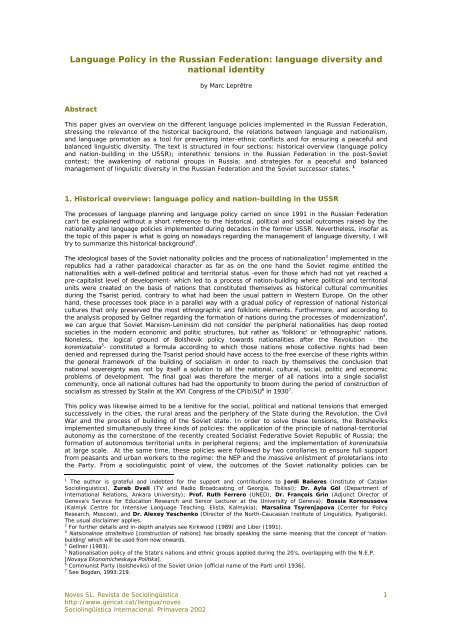
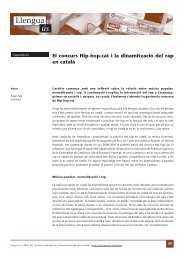
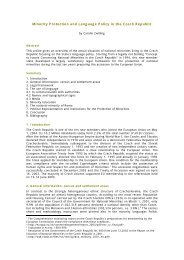

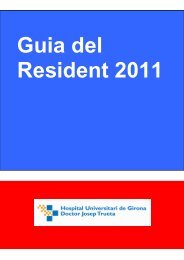

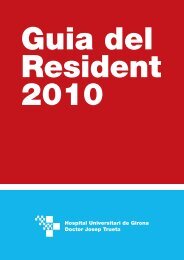

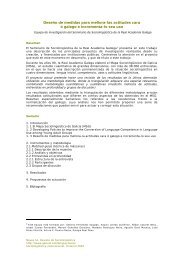
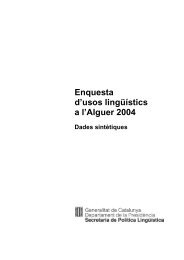
![Mestres, J.M. [et. al]. Manual d'estil: la redacció i l'edició de textos](https://img.yumpu.com/31252673/1/184x260/mestres-jm-et-al-manual-destil-la-redaccia-i-ledicia-de-textos.jpg?quality=85)
